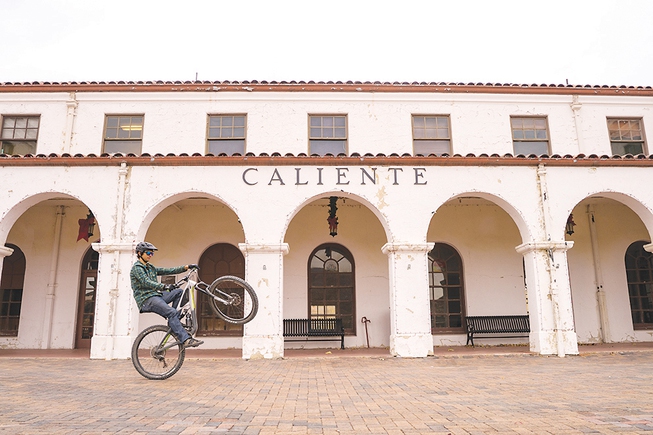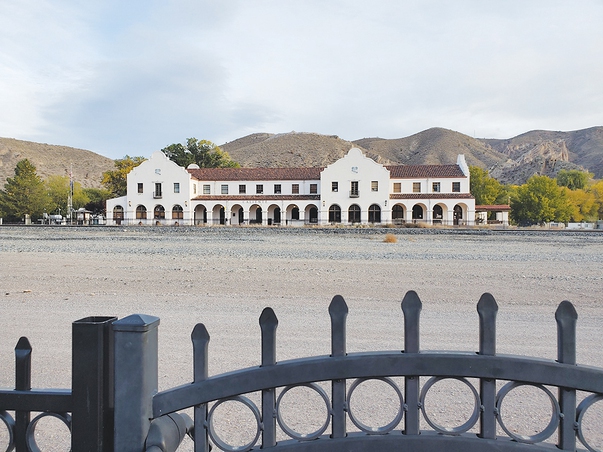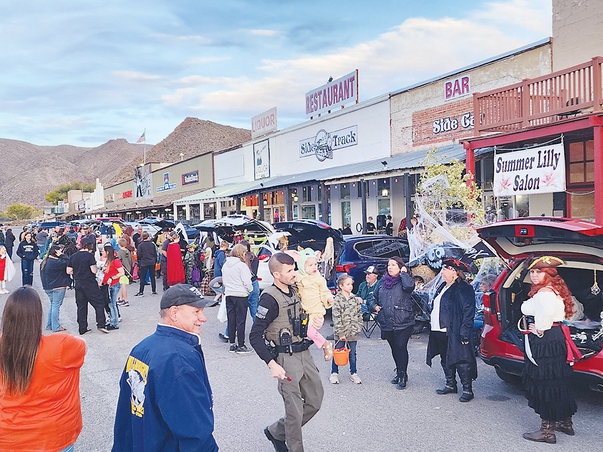
Leslie Kehmeier / Special to the Sun
A bicyclist pops a wheelie in front of the historic Caliente Train Depot, a classic mission-style building that dates to 1923. The building — in Caliente, about 150 miles northeast of Las Vegas — is undergoing a renovation, with a grand opening tentatively slated for summer 2024.
Sunday, Dec. 3, 2023 | 2 a.m.
•First in a series
Nevada is a sprawling state with most of its people in two population centers. But beyond the reaches of Las Vegas and Reno is a land filled with attractions and history. Some of them, of course, might not be familiar to most Nevadans. The Sun has reached out to mayors and representatives of the Silver State’s 19 cities, giving them a platform in our pages to talk about their area’s history and attractions and to describe what makes them special and what challenges they face. Today, we present a Q+A with Caliente Mayor Steve Rowe.
Give us a history lesson. What makes your jurisdiction unique?
Located in southeastern Nevada, the quiet town of Caliente is the only incorporated community in Lincoln County.
The meadow area around the junction of Meadow Valley Wash and Clover Creek was originally settled in the early 1860s by Ike and Dow Barton, two slaves who had escaped from Arkansas. In the early 1870s, the area was known as Dutch Flat, with Jackman Ranch being established. In 1874, ranchers Charles and William Culverwell purchased the Jackman Ranch and renamed it as Culverwell Ranch. The town was later referred to as “Culverwell.” Along with ranching, the family earned a living by providing hay for the mining camps in Pioche and Delamar.
A dispute between two major railroad companies began when E.H. Harriman of the Oregon Short Line and Union Pacific, pushed track from Utah to the site of Culverwell. Even as Harriman’s crews worked on the line, the newly formed San Pedro, Los Angeles and Salt Lake Railroad owned by Sen. William Clark claimed the same territory. These rival groups had sought the right-of-way in a canyon only big enough only for a single set of tracks. The Union Pacific had grade stakes set all the way into Culverwell and on toward Pioche, but their rival group gobbled up enough of the narrow canyon to set a roadblock in the path of Union Pacific.
William Culverwell in 1901 ended the Harriman-Clark battle with his shotgun. As owner of the land, Culverwell allowed one railroad grade to be built through his property. The two factions eventually reconciled, Union Pacific assumed control of the project. Culverwell became “Calientes” (the Spanish word for hot) after the hot springs found in a cave at the base of the surrounding mountains. The town was surveyed, and on Aug. 3, 1901, a post office opened and postal officials renamed the town Caliente. The railroad line was completed in 1905, and by 1910, Caliente was the largest town in Lincoln County with 1,755 residents.
A two-story wooden structure served as a train depot until burning down in one of Caliente’s disastrous fires. In 1923, the impressive Caliente Train Depot was built, a classic mission-style building constructed of tan stucco. This two-story building included the railroad station, private offices and a community center on the first floor, while the second level featured a hotel.
Within a few years, Caliente grew to more than 5,000 residents. For more than 40 years, Caliente was one of the major division points on the railroad line. When steam engines were replaced by diesel locomotives in the 1940s, the division point moved to Las Vegas. Without the depot as a main railroad stop, the town’s growth dwindled but not its spirit.
A town steeped in history, Caliente has many stories to tell and was one of the favorite writing spots for western novelist Zane Grey.
What kind of attractions and events do you have that people may be interested in visiting?
The depot is undergoing a historical restoration with the exterior completion expected next spring. We hope to have a grand opening in the summer of 2024.
For sports and recreation, there are four city parks, a public swimming pool, a shooting range and a motocross race track that borders an access point to the 250-mile Silver State OHV Trail System. Caliente has five state parks located within 50 miles of town: Kershaw-Ryan, Beaver Dam, Cathedral Gorge, Spring Valley, Echo Canyon — and the historic Elgin Schoolhouse. Each offers its own unique experience.
The outdoor enthusiast has access to numerous trail systems including the hottest new biking destination in the West. The nearly 60 miles of mountain bike trails have everything from technical descents to dirt jumps to fast flow; our trail systems have something for every rider — and we’re still building! We plan to have fully linked, purpose-built single-track to thrill any rider, no matter their riding style or ability. And don’t get us started on the hundreds of miles of gravel grinding. There is also a bike skills park with direct connection to the city. Caliente is the hub for off-road racing, for both motorcycles and quads, with easy connections to the Silver State OHV Trails.
The area’s beautiful terrain, sunny climate, great trails and classic desert solitude create an unrivaled outdoor recreation experience. The small hometown feel welcomes folks to find the “off-the-beaten-path” experience that can be found in activities including barbecues, softball tournaments, Memorial Day Weekend celebration and the Fourth of July celebration drawing visitors from all over with great food, dancing, games for the kids and a dazzling fireworks display.
What new development opening in 2024 has you excited? Why?
The grand reopening of the train depot will be a big event for Caliente. Plans are to bring in a steam engine for that weekend celebration of our historic ties to the railroad. Our tourism board is also developing experiences for visitors that will enhance visits and help guide them to our out-of-the-way hidden gems.
What is the biggest challenge facing your jurisdiction?
Increase in traffic to our area has been an issue ever since the state created a bypass away from Caliente by building State Route 318. The drop in traffic utilizing U.S. Highway 93 has seriously affected the economy of eastern Nevada. The long-ago promise to provide an all-weather route to Caliente from Las Vegas via a completed State Route 317 never developed any further than Elgin. We are attempting to compensate for this by increasing destination marketing concepts.
Because of the slowdown of economic development, the city of Caliente is challenged with housing shortages and bringing new industry to such a rural place. We have an industrial park and are willing to offer a good deal on some land if there is interest in bringing new businesses to town.
What industry is most important to your town’s economy? What about diversifying?
Caliente started as a railroad town, but over time the railroad has become more mechanized and railroad personnel are fewer and fewer. Now Caliente depends on state and county departments for jobs such as Caliente Youth Center, Nevada Department of Forestry, Lincoln County School District, Bureau of Land Management, Nevada Test Site and others. Caliente is open to diversifying if new business and industry are interested in this area. Tourism is being explored as an economic driver as well.
What opportunity does your community provide for public education? What challenges does it face?
Students attending elementary, middle school and high school in Lincoln County obtain a quality education preparing them for college success as well as rewarding technical jobs. With a total student enrollment under 1,000, an average class size of just 16.5 students and a student-teacher ratio of 13.9:1, the education students receive in Lincoln County is focused on individual needs and achievement. Program funding for expanded learning experiences can sometimes be a challenge.
What challenges do your residents face with health care availability and cost?
The Lincoln County Hospital is located in Caliente along with a medical clinic. We have good basic health care; however, due to our size we don’t have surgery or specialty services.
Nevadans have lived with historic drought for the past two decades. What initiatives are in place to save the valuable commodity of water?
Caliente’s water supply is pumped from wells. The city consumes less water than 20 years ago, having water meters installed on each well to monitor usage.
What issues are facing your community regarding roads and transportation?
Caliente is located on U.S. Highway 93 with bridges on both ends of town. In the past there has been flooding that compromised both bridges and when one or both are out of service, the town is essentially cut off from the rest of the state. There is no public transit that services the town or surrounding areas.
How can public safety be enhanced in your community?
The city of Caliente depends on the Lincoln County Sheriff’s office for law enforcement; they do their best to cover the county and Caliente at the same time. More staffing would help.
What is one thing you wish the rest of the state knew about your jurisdiction?
Visiting Caliente is like walking into the past. People smile and wave, even if they don’t know you; they are willing to share local knowledge and point you in the right direction. We may have limited infrastructure but it is enough.
Caliente is part of the approximately 10,600 square miles that make up Lincoln County, of which nearly 98% is public or nationally designated land. The scale of our county positions us as the seventh-largest county by landmass in the nation; yet the 2020 census shows a population of only 4,500, making it Nevada’s fourth least-populous county. Its southern portions are located only about 50 miles from central Las Vegas, making it easily accessible for both Las Vegas residents and visitors. U.S. Highway 93, which stretches from close to Mexico to Canada, passes from the county’s southern border to its northern reaches and is its main travel route.
Visitors have come to Lincoln County for years, attracted primarily by its range of outdoor experiences and unique natural environments. The diversity of attractions near Caliente extends to historical, heritage, rock art, rock climbing, hot springs, wildlife viewing, and some of the darkest skies in Nevada.



